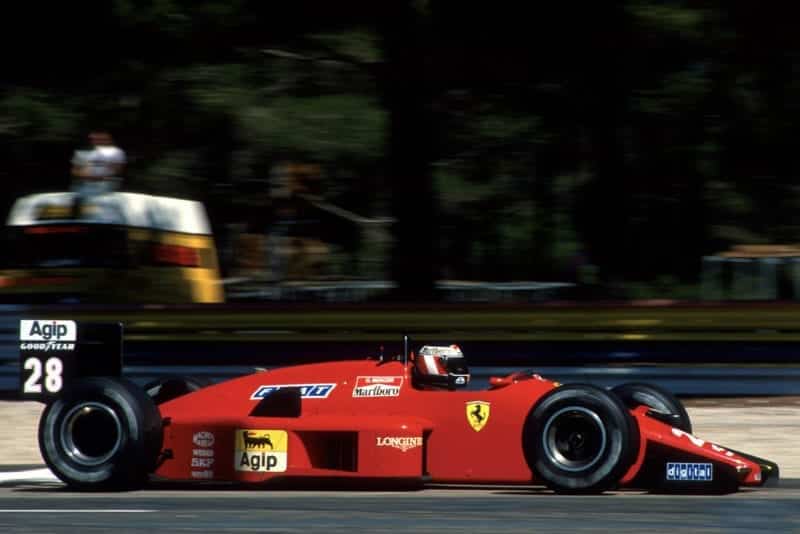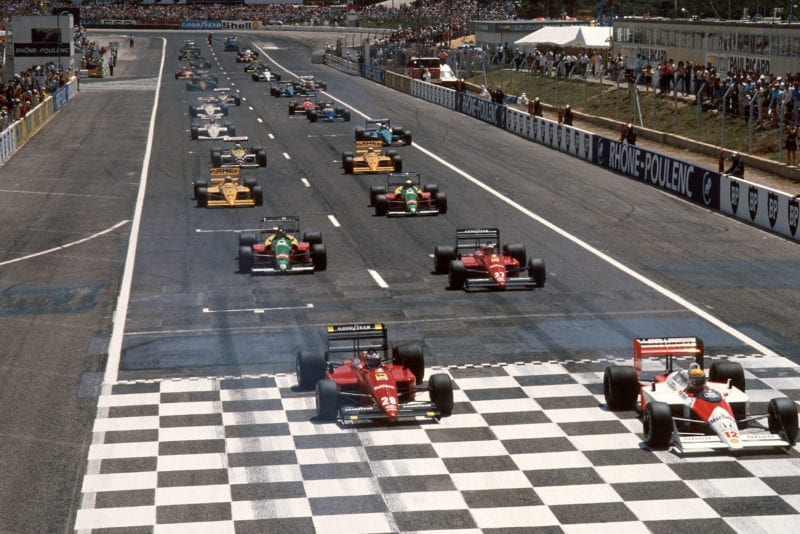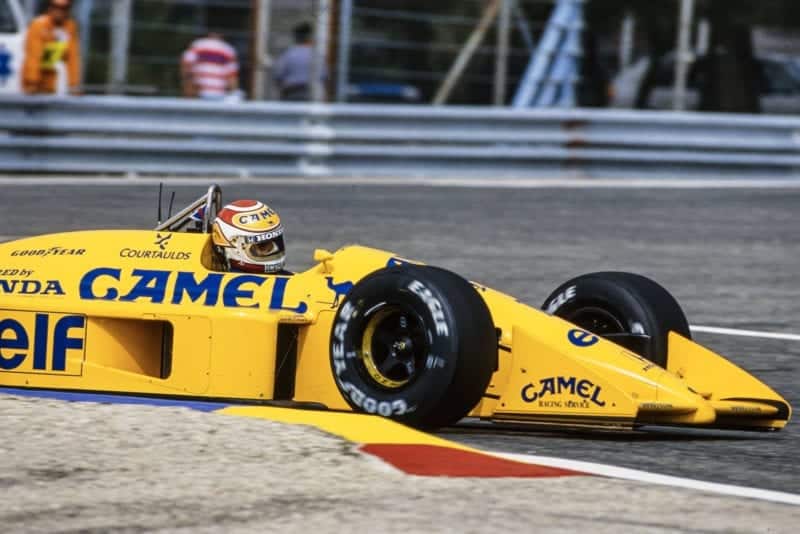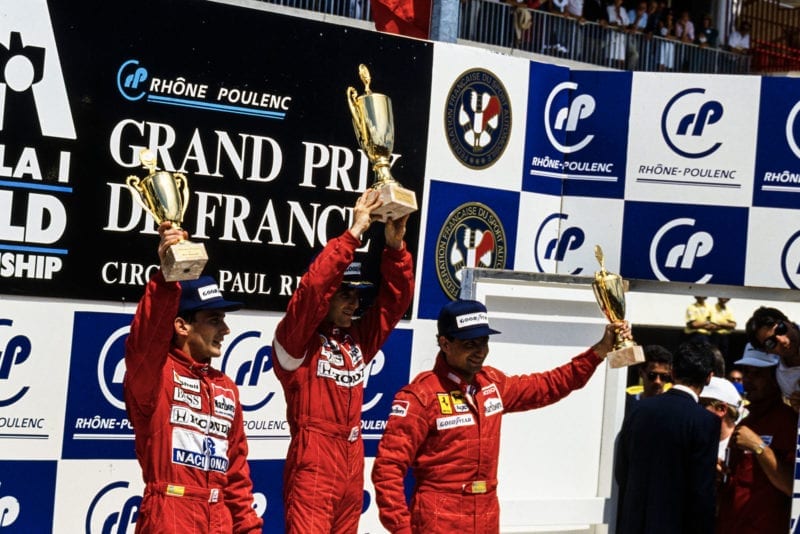1988 French Grand Prix rae report

McLaren's Alain Prost extended his points lead with a win at Paul Ricard
Motorsport Images
A Special Occasion
It had to happen. For the first six Grand Prix races of 1988 Alain Prost has appeared to be content to let his Brazilian team-mate set the pace, with blindingly quick qualifying laps that gave him six consecutive pole-positions. He agreed to Senna having first call on the McLaren-Honda T-car for those events, and when Senna had trouble in the race (as in Brazil) or crashed (as at Monaco) or got elbowed out at the start (as in Mexico) Prost eased serenely into the lead.
The score before the French Grand Prix was three wins each, but more impressive, and more important to the overall scene, was the fact that the McLaren-Honda MP4/4 cars had won six races out of six.
At the flat and featureless Paul Ricard circuit, on the arid plain in the mountains behind the Mediterranean coast-line between Toulon and Marseilles, Prost arrived with his name on the McLaren T-car and a very aggressive will to win at all costs – quite unlike the normally cool and placid Monsieur Prost.
Outwardly it did not show, but when it came to racing it was another story and in qualifying he was nearly half-a-second faster than Senna. His driving was visibly aggressive, using all the road and more, braking so late that even Senna was beginning to look quizzical. This was not the real Alain Prost, this was something special which he obviously kept in reserve for special occasions. For Prost, the French Grand Prix was a special occasion, and his performance caused quite a few eyebrows to be raised (including those of DSJ).

Ferrari’s Gerhard Berger put his car 3rd on the grid
Motorsport Images
In the race it was just the same, he made a superb start and was gone; all that Senna could do was keep up with him.
The race was over 80 laps of the truncated Paul Ricard circuit, and while the Honda men were confident about the ability of their engines to run at race-winning speed and to consume less than the permitted maximum of 150 litres, the Goodyear men advised a change of tyres about half-way through the race.
Senna came in on lap 31, leaving Prost to sail away into a long lead, but the Brazilian was back into the race on new tyres before the third-placed man came into view. Such was the domination of the McLaren team, long before half-distance.
On lap 33 it was Prost’s turn for a tyre change, and his speed down the pit-lane and onto the marked-out space in front of the McLaren pit was perfection. Jacks under, wheel-nuts off, old wheels off, new wheels on, wheel-nuts on and… there was a heart-stopping moment of two seconds, three at the most, as the left front wheel, or the nut, baulked. Then the car was down and the Frenchman was away, but as he let in the clutch Senna sailed by into the lead. The question was: “So now what?”
The McLaren team orders are simple enough: the cars must finish first and second, which order they are in is up to the drivers. When your drivers are Prost and Senna you don’t have to worry about them doing stupid things that might upset the overall concept of first and second.
With the race half-way over, there seemed to be slow cars all round the circuit, which by any standards is a bit “micky-mouse” with a lap time of 1min 12sec for the leaders. Fortunately the circuit is more than adequately wide, so overtaking is not a great problem, and most drivers have become accustomed to seeing a red-and-white car looming up in their mirrors, knowing full well that the second one will not be far behind. There was nothing Prost could do about Senna, in the same way that Senna had been unable to do anything about Prost in the opening stages, so it was a sort of friendly stalemate. For once Prost was a bit more audacious in his overtaking, as he followed Senna through the ranks of the slower cars, closing up and waiting for something to happen.
What he didn’t know was that Senna was having trouble with his fifth and sixth gear selection and under high-speed braking he could not rely on fifth engaging cleanly to help him slow down, having to rely more on the brakes than he wanted to. Occasionally he was locking up a front brake, a sure sign that he was arriving at a corner a bit too fast, caused by not having the assistance of the “over-run” on the engine. This meant that he had to reduce his personal limits just a fraction, and eliminate chancy moments.
It was just this situation on lap 61 as they peeled off the back straight into the fast right-hand sweep. Senna was about to lap a slower car, and the worry that his car might jump out of gear at an embarrassing moment caused him to hesitate behind it. That was all Prost needed, and in a clean and precise move he was through on the inside, past both cars and into the lead.
By the time Senna had untangled himself from behind the slower car it was all over. Luckily for everyone who was not at Paul Ricard, the television cameras caught the whole thing and beamed it round the world. For those watching from the pits the two McLarens had merely changed places!
All this time the two cars from Woking had been running hard and overdoing it on fuel consumption, in spite of warnings from the pits, but they were not going to throw the race away. In the closing stages they eased off and cruised safely home, Senna now having difficulty finding second gear in his gearbox, and some of the slower cars that had been lapped twice went by the red-and-white duo, to regain a lap.
Prost took the chequered flag with great joy and satisfaction and continued round on a slowing-down lap – no longer obligatory, but much appreciated by his compatriots. It was the French Grand Prix, he is the best driver that France has ever produced, and from the first day of practice you just knew he was going to win this one, with no messing about. Senna pulled off the track as soon as he crossed the line, glad that it was finished and not slow to acknowledge that the French Grand Prix had been Alain Prost’s day and there had been nothing he could do about it.
That was race A, or to be more precise, race M (M for McLaren). But what about race B (B for back-markers, or should it be A for also-rans?)?
Two years ago, when the rules were announced that turbocharged engines would be cut down to a maximum of 4-bar in 1987 and 2.5-bar in 1988, someone remarked that it would be good for the sport. They said that teams which could not cope with hi-tech turbo engines could dig out their old Cosworth DFV engines, enlarge them to 3½-litres of DFZ, and start winning races again.
Leo Mehl, the head of Goodyear racing, grinned and said, “Don’t kid yourself.” That was before anyone had seen a turbocharged engine restricted to 4-bar, let alone 2.5-bar and I always felt that Leo Mehl knew what he was talking about. You don’t make tyres for Honda and Ferrari without knowing what is going on behind the scenes in Research and Development.
For those who are interested in category B (i.e. the non-McLaren part of the entry) there is much of interest, even if it is of only secondary importance at the moment.

The cars pull away at the race start
Motorsport Images
Ferrari is still there, using basically its 1987 car and engine, and in spite of typical Italian intrigue within the management Gerhard Berger and Michele Alboreto shouldn’t complain while they can keep the McLaren pair in sight for a moment or two. At the French Grand Prix Dr Harvey Postlethwaite was absent, it having been announced that he is leaving Ferrari and returning to England, and John Barnard seemed to be in charge.
Barnard’s new car with the 3½-litre V12 engine is likely to appear sooner than expected, now that the turbocharged cars cannot catch the McLaren-Hondas. Once McLaren has amassed enough Constructors’ points to become unbeatable, there is no point in Ferrari flogging a dead turbo car in order to finish second in the championship, so it might just as well get ready for 1989 with its new car and engine.
Alboreto has made it clear that he is finished with Ferrari at the end of this year and there is little incentive to “bust his gut”, whereas Berger is still full of fighting spirit and actually split the McLarens away from the start, down to the first corner. He drove hard, as he always does, but had to pay the price with an early stop for tyres on lap 23, while a spin on the lap before lost him an additional 15 seconds. The Ferrari mechanics did a super job on the wheel-change, and as the car came off the jacks Berger had the engine bouncing off the rev-limiter and just dropped the clutch. It was spectacular and so typical of the “never-say-die” attitude of the Austrian.
Meanwhile Alboreto was driving round neatly and tidily, regularly and fast, and was staying on the same lap as the McLarens, in spite of a tyre stop. When they slowed up in the closing stages it allowed Alboreto to keep on the same lap right to the finish, but Berger had to slow right down as his fuel-reading was warning him he wouldn’t finish if he didn’t obey the signals.

Nelson Piquet took 5th for Lotus
Motorsport Images
It is still difficult to see exactly why the McLarens can lap Nelson Piquet’s Lotus 100T when both teams have Honda power, but it is rather like the Williams cars being competitive with the Judd engines while Ligier, also with Judd engines, fail to qualify, as Arnoux and Johansson did yet again.
In between is the March team, also using Judd engines, and two likely-lads Capelli and Gugelmin get quietly on with the job, learning and improving while they go. Capelli was still suffering from his foot injury received in Detroit, but made no heroics about it and drove a consistent race with one stop for tyres. Gugelmin went through non-stop, nursing his mechanical components rather than the tyres, as things had reached desperation point on Saturday morning and it was only by dint of a lot of hard work and improvisation that the team was able to field two cars on race day.
On Saturday morning there wasn’t a complete March to be seen. All three cars were strewn over the garage floor in many pieces and the last of their Judd engines had been used up. Somehow miracles were worked, and both drivers qualified on Saturday afternoon, both started the race and both finished. It was no surprise to see Capelli and Gugelmin sitting on a couple of chairs in the paddock, long after the Leyton House motor-home had been packed up and most drivers and important people had gone off to their Lear jets or helicopters. They had done a good job, they knew it, so why shouldn’t they sit quietly and enjoy the evening sun with some friends?
For once, the Judd engines were not the Achilles Heel of the Williams team, though they could not match the works Cosworth engines in the Benetton for speed. Both Williams cars faded from the scene almost unnoticed, Mansell with a suspension failure, and Patrese with brake mechanism trouble. Just as it has been announced that the Williams team will have the full support of Renault in 1989, with its new V10 engine, Mansell appears to be deserting the ship and joining Ferrari next year.
While they ran, the Benetton cars were in cracking form, heading all other non-turbo cars, as well as the Arrows-BMWs, turbo Zakspeeds and Osella, and the two Lotus-Hondas on the starting grid. To really put it into perspective, Thierry Boutsen was only beaten in qualifying by the two McLarens and the two Ferraris.
This was in spite of running out of cars on Saturday morning when both DFR engines cut out and stopped due to some obscure electrical interference making the “chips” go on the blink. After the cars were towed back to the pits both fired up and ran perfectly. This is an electronic phenomenon that has affected a number of other teams this year, with no symptoms or eventual faults to be found. Both Boutsen’s cars suffered while Nannini’s engine didn’t miss a beat.

It’s a McLaren 1-2 one the podium
Motorsport Images
In the race it was the same again, and Boutsen was out before half-distance after two stops to change suspect components without any improvement to the misfire. He had been running a strong sixth. Nannini had been running strongly behind Boutsen in the opening stages, and took over sixth place to lead the 3½-litre brigade to the finish, one lap behind the McLarens.
Of the rest one cannot help but wonder whether they wouldn’t be better off running in Formula 3000, and, as the season progresses and the pace at the front gets hotter, how many will survive to the end of the year. DSJ
